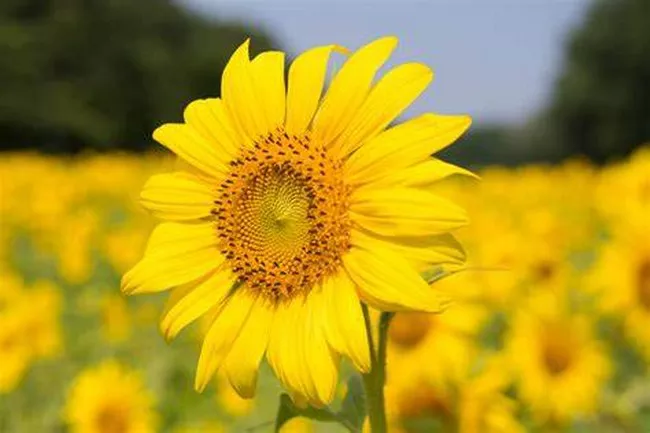HIGHMORE, S.D. — In the Dakotas, sunflowers are more than just a pretty sight in late summer; they are an essential economic resource for farmers in both North Dakota and South Dakota, the leading states in sunflower production. Despite their primary use as bird feed across the U.S., sunflowers serve a variety of purposes, including confectionery food, medicinal uses, oils, and ornamental applications.
However, sunflower production in the U.S. has seen a significant decline. In 2023, the country produced 2.26 billion pounds of sunflowers, a sharp 19.4% decrease from the previous year’s 2.81 billion pounds, according to data from the U.S. Department of Agriculture (USDA).
Tom Young, Executive Director of the South Dakota Oilseeds Council, emphasized the profitability of sunflower farming in central South Dakota, particularly in Sully County, which has a longstanding reputation as one of the top sunflower-producing counties in the nation.
“In central South Dakota, we really enjoy growing sunflowers,” said Young. “They’re beautiful in the middle of August.”
North Dakota maintained its position as the top sunflower-producing state in 2023, with a total harvest of 1.12 billion pounds. However, this figure represents a 16.2% decline from the previous year. South Dakota followed with 817.2 million pounds, marking a 24.5% reduction in production.
Young attributed the nearly 30% drop in South Dakota’s sunflower production to the red sunflower seed weevil, a small, reddish-brown beetle that has become a significant pest in the central and northern Plains.
“Currently, we’re exploring ways to combat this issue,” Young explained. “We’ve lost access to some of the chemicals that were previously effective in controlling the weevil, which has led some producers to reduce their sunflower planting until we find better solutions.”
The South Dakota Oilseeds Council is working in partnership with South Dakota State University and other organizations within the National Sunflower Association to address the seed weevil problem.
“We’re collaborating with our state entomologist and conducting joint research to tackle this pest,” said Young. “It’s a great opportunity to work together with neighboring states and producers to enhance our crops.”
Farmers like Nick Nemec from Hyde County, South Dakota, have been grappling with the seed weevil on their sunflower fields. Nemec, who farms 320 acres of sunflowers, recently treated his fields in an effort to control the pest.
“We sprayed this field just a few days ago for seed weevils, and hopefully, that’ll keep them in check for the season,” Nemec said. “We try to choose a chemical that’s less harmful to honey bees since we have bees pollinating the flowers.”
Nemec, who also cultivates corn and soybeans, has been growing sunflowers for over 50 years. Despite the challenges, he remains optimistic about the 2024 crop.
“We could use an inch of rain — that would really help fill out the flowers,” he noted. “The flowers fill from the edge inward, and more rain helps fill the center of the head.”
The USDA National Agricultural Statistics Service reported that for the week ending August 11, sunflower conditions in South Dakota were rated 0% very poor, 4% poor, 20% fair, 73% good, and 3% excellent. In North Dakota, the ratings were similar, with sunflower conditions at 0% very poor, 1% poor, 28% fair, 68% good, and 3% excellent.
Nemec was able to plant his sunflower crop in late May, after finishing his corn and soybean planting. He finds sunflowers to be a valuable part of his crop rotation, particularly for weed control.
“Some of the chemicals we use on sunflowers help break up the weed disease cycle, which is a nice addition compared to a straight wheat or corn rotation,” Nemec said.
Nemec hopes to harvest his sunflowers in November, aiming for a crop that weighs around 30 pounds per bushel, surpassing the 28-pound standard preferred by local buyers.
“We make sure to spray for the seed weevils so they don’t damage the seeds,” he explained. “We also adjust the combine to blow out empty or partially filled sunflower hulls.”
Local marketing opportunities play a crucial role in Nemec’s farming operation. He sells his crop through Prairie Grain Partners and Global Harvest Foods in Harrold, South Dakota.
“It’s really convenient to have a bird seed plant — an end user — just a few miles from your farm,” Nemec said.
John Simonson, another sunflower farmer near Highmore, South Dakota, also benefits from local marketing, selling his crop through Sunbird and Advanced Sunflower in Huron, South Dakota. Recently, he has started exploring the oil market, working with ADM in Enderlin, North Dakota, and Cargill in West Fargo, North Dakota.
Simonson and his stepson manage a rotation of about 5,500 acres, including winter wheat, spring wheat, corn, millet, milo, soybeans, and sunflowers. Each year, sunflowers account for around 1,000 of those acres.
“Sunflowers are a very profitable crop,” Simonson said. “We’ve never had a year where we’ve really had a loss on sunflowers.”


